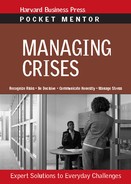Stage 6: Learning from the Crisis

WHEN YOU SURVIVE a crisis, don’t just try to put it behind you. Rather, take the opportunity to learn from the experience and make changes to avoid or prepare for another similar event. Engineers, for instance, use earthquakes as a learning experience to plan for stronger roads, bridges, and buildings. They use massive floods to determine the best ways for people to adapt to the power of nature (build dams or dikes) or yield to that power (move out of a flood plain).
You, too, can do a postcrisis audit to learn and even profit from the event. For example, when everyone in the catalog company worked overtime to fill a large volume of orders they hadn’t expected to receive, they successfully handled the immediate crisis. But operating in crisis mode is an ineffective way to work all the time. It takes its toll on morale, turnover, and the health of everyone, especially the manager. After the rush at the catalog company, people were given large bonuses and extra vacation time. Then management took steps to plan for the next year, so the company would be prepared to meet a large demand—with less pressure on the employees.
Reviewing how the crisis was handled
Plan the timing of the crisis review soon enough after the event so that people remember details, but long enough afterward for some emotional healing to have taken place. Start by analyzing the crisis from beginning to end. Pinpoint actions, assumptions, and outside factors that precipitated the crisis. Ask yourself the following questions:
- Knowing what we knew then, could we have prevented the crisis? If so, how?
- At what point did we realize we were in a crisis? Could we have recognized the signs earlier?
- What warning signals went off that we may have ignored?
- What warning signals did we pay attention to?
- What were the early signs? Why were they turning points?
- What did we do right? What could we have done better?
- What were the stress points in the system that failed?
Planning for the next one
Knowing what you know now, how can you prevent the same type of crisis from occurring again? Create a plan so that you learn from what you know.
- Get input from everyone. You need to get everyone’s story, but pay attention in particular to those with expertise in the areas of importance. If the crisis was technological, then listen to the computer experts, the IT group, the network engineers. If the crisis was relational—a critical vendor cuts off your supply of goods—talk to your buyers, but then go out in the field and find out what happened and why.
- Incorporate the ideas and information in your next round of strategic planning. You’ve already performed your first crisis audit. Now you’ll have much more knowledge to improve the revised audit and the crisis-prevention plan.
Successful managers make each crisis a learning experience. For example, the catalog company experienced a crisis when its phone lines were swamped after the release of its holiday catalog. Management listened to employees and outside consultants. Consultants analyzed workflow, looking at bottlenecks and technology. And everyone in the company who had worked in the warehouse to help get through the crunch now understood firsthand how the business was run. Their experience had taught everyone a great deal. The CEO set up a system to tap into the cumulative knowledge of the company’s workforce. The firm set up a suggestion program and put many resulting ideas into practice. Each quarter, it gave a $100 reward to the employee who came up with the best idea.
Tracking results
Track the results of changes you make after the crisis. How are they working? Will they actually reduce the negative impact of a future event? For example, as a result of a comprehensive analysis and much planning, the catalog company was well prepared for the next season. Some of the realizations and improvements that were generated by the analysis included those shown in the table “Tracking results.”
| Tracking results | |
|---|---|
| Problem identified | Action taken |
| The outdated IT system was incapable of handling the large volume of business. | The system was redesigned and overhauled. The division grew from one of the smallest in the company to one of the largest. |
| There were too many colors for customizable items, which caused delays in processing orders. | The number of colors offered was reduced; offerings were streamlined. |
| Most of the orders came in a three- month period, while it was slow the rest of the year. | More catalogs were offered throughout the year. |
| Many shoppers ordered at the last minute, creating enormous demand on resources at one time. | To spread out the frequency of demand, incentives were offered to encourage customers to order earlier in the season. |
| Too many catalogs went out at once. | The release of catalogs and ability to respond was tracked, so that systems were always in place to handle demand. |
